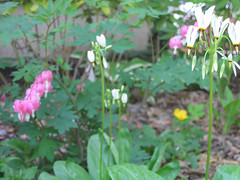More on the Eastern Shooting Star
 I am very excited to have ignited some interest in shooting stars with my photos of the specimens blooming in my shade garden. I hardly need more of an invitation to rave about this little gem.
I am very excited to have ignited some interest in shooting stars with my photos of the specimens blooming in my shade garden. I hardly need more of an invitation to rave about this little gem.My first encounter with the genus (Dodecatheon) was working for the National Biological Service in Yosemite National Park. I participated as a research assistant (through the SCA) on a number of ecological studies, including one on the impact of livestock grazing on the alpine meadows. Dodecatheon jeffreyi (a pink flowering species) was one of the many lovely wildflowers growing in the study sites. This was my first encounter with shooting star and I found them absolutely enchanting. I loved their delicate nature and swept back petals. After the all-too brief alpine spring passed, the blooms disappeared, but I grew very familiar with its fleshy, basal foliage as the summer progressed.
After studying botany on the west coast, eastern wildflowers (and native eastern plants in general) are a whole new ballgame for me. I had no idea that shooting star grew on this side of the Mississippi, and was even more surprised to find that they were white and fragrant. Dodecatheon meadia, Eastern Shooting Star, can actually be lilac, pink, or white. They are in the primrose family and have a fibrous root system. They can be propagated by seed, but you’ll have a long wait (3 years) to see blooms. A better method of propagation is by division. Although my alpine shooting stars grew in the open meadow, under blazing, high-altitude sunshine, the eastern shooting star prefers some shade. The foliage does die back in the summer, so I’ve companion planted with mini-hostas (courtesy of Pam), this year.
I was lucky enough to receive my shooting stars for free, from a portion of Tim’s yard that he plans on renovating. I believe they were self-sown from a plant or two he collected from privately owned land. (Correct me if I’m wrong, Tim.) Many states list the shooting star as rare or endangered, so they should not be generally collected from the wild. It seems that very few nurseries carry this plant. If you find a reputable source, though, I highly recommend it!
*Another reason I love this plant is that the genus name, Dodecatheon, reminds me of the stupid Dodecahedron in the Phantom Tollbooth movie. In fact, that’s how I remembered the name for the meadow study.


1 Comments:
Thanks for mentioning this post in my blog. I used to grow Shooting Star when I lived in Ottawa and had a patch that seemed to increase every year. Now I'm just happy to have my lone Shooting Star appear. I was quite surprised to find a tray of Shooting Star at a garden centre a few years' ago...
Mine dies back soon after it blooms, so for a few glorious days, I enjoy it.
It must have been great fun doing research in Yosemite. You've led an interesting life.
Post a Comment
<< Home